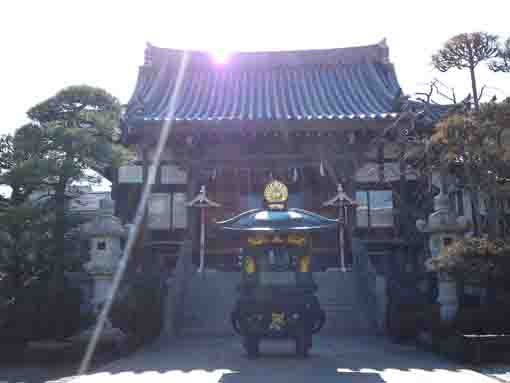Nakayama is in between Narita And Haneda International Airport
<クッキーについての同意並び欧州居住者向けプライバシーポリシー>
中山・下総・散歩道
Setsukosan Shofukuji Temple in Urayasu and Shinabi Jisoson




Setsukosan Shofukuji Temple is only one temple belonging to Nichiren sect in Urayasu City. It stands on the south of Sakaigawa River flowing with the history of the city. The temple dedicates a famous stone statue having miracle power to cure skin disease called 'Shinabi Jizo' and 'Joko Bosatsu' on the end of a beautifully arranged long stone pavement approach road. Shofukuji Temple is a blanch temple of Nakayama Hokekyoji Temple built in late Azuchi Momoyama Period in 1593. Why don't you visit Setsukosan Shofukuji Temple?
Shinabi Jizoson
Shinabi Jizoson
Once upon a time, there was a family called Shinabi in Horie village. Oneday, a master of the family found a Jisoson without its head in a burnt field when he went to Edo for his business. He promised to it to fix its head. Soon after he took it to his house and prayed for cure his skin disease, his skin recovered. Then he fixed it and dedicated it carefully.Later, the Shinabi was adapted into Ikeda Family, and the Jizo was moved to the Ikeda's resident. In 1963, Nichiin, the 19th chief priest of Shofukuji Temple, built a shrine to dedicate the Jizo in the site as the resident was rebuilt.
Even now, many people who find the miracle power of Shinabi Jizo visit the temple and pray.
Febraury 2008
Urayasushi Board of Education
説江山正福寺しなび地蔵尊前案内板より
Jogyodo
Jogyodo
Jogyodo is a hall or a shrine where Jogyo Bosatsu is dedicated in.This statue of Jogyo Bosatsu was dedicated by the venerable Kenmyoin Nisshin, the 17th chief priest, in March 1895.
Jogyo Bosatsu is one of the four Bosatsu such as Jogyo, Muhengyo, Jogyo and Anritsugyo Bosatu, who could save people and all living things in the end of the world where Buddhism would be declined and the world be corrupted. Jogyo means that one do everything clean.
This sculpture has been believed as an Arai Botoke, it means that one clean a part of the Bosatu's body to cure one's disease if one has it on the same part of one's body. It is popular among people and is called Jogyosama.
This Jogyodo shrine was rebuilt when the approach road to the main hall was fixed from 1992 to 1994.
January 2004
Urayasushi Board of Education
説江山正福寺浄行堂前案内板より
引用・抜粋ならび参考文献
説江山正福寺しなび地蔵尊前案内板
説江山正福寺浄行堂前案内板
説江山正福寺ホームページ
江戸川ライン歴史散歩 崙書房
The Location and Access to Setsukosan Shofukuji Temple

The map of the noted spots near Urayasu Station
PDF of the map of the landmarks near Urayasu StationSetsukosan Shofukuji Temple
- Setsukosan Shofukuji Temple has a great accessibility from both Narita and Haneda International Airport.
- From Narita International Airport, take JR Sobu-express line, transfer the line at Nishi-funabashi to Tozai line of Tokyo Metro bound to Nakano or Mitaka, get off Myoden Sta. And also take Keisei-line, transfer the line at Funabashi to Sobu-Local line, and transfer the line at Nishi-funabashi to Tozai line of Tokyo Metro bound to Nakano or Mitaka, get off Urayasu Sta. It takes minimally 60 minutes from Narita Airport.
- From Haneda International Airport, take Keikyu-line bound to Narita, transfer the line at Nihonbashi to Tozai line of Tokyo Metro bound to Nishifunabashi, Tsudanuma or Katsutadai, get off Urayasu Sta.
- From Tokyo (Otemachi) Sta, take Tozai line of Tokyo Metro bound to Nishi-funabashi, Tsudanuma or Katsutadai, get off Urayasu Sta.
- From Akihabara Sta, take Sobu line bound to Chiba, Tsudanuma or Nishi Funabashi, transfer the line at Nishifunabashi to Tozai line of Tokyo Metro, get off Urayasu Sta.
- Take 10 minute walk from Urayasu Sta.
- 2-6-35 Horie, Urayasu-shi, Chiba-ken
The Landmarks in Horie and Nekozane

Udagawa House
It is an old house that tells the history of Tokyo Bay Areas.
Otsuka House
It is an old house registered as a cultural property by Chibaken.
Seiryu Jinja
It has some historical and cultural assets of Urayasu.
Seiryusan Kannonji Hojoin
It has koshinto tower and the statue of Binzuru Sonja.
Koryokusan Shiseiin Dairenji
This temple has a statue of Seishi Bosatsu carved by Gyoki.
Iousan Togakuji
The statue of Yakushi Norai on a turtle in it is famous.
Sekkousan Shofukuji
The statue of Shinabi Jizo in it is said to have power to cure skin troubles.
Kaishosan Kezouin
The monument for the Fulfillment of Prosecutionof Shell Gathering tells the history of Urayasu.
Toyouke Jinja
The oldest shrine in Urayasushi has a 300 years old huge gingko tree standing in it.
The 33 Pilgrimages in Urayasu and Gyotoku
It was a popular and reasonable trip for people living in Edo.- 広告 Advertisement -
